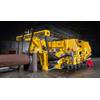Seismic: The Motion Picture
Shell technology creates sharper pictures of underground rock formations to find new oil and gas fields more cost effectively.
Shell has found a way to use tiny motion sensors – like those used in modern everyday gadgets – to create sharper pictures of underground rock formations.
Geophysicists map underground rock structures by sending seismic waves – essentially sound – through the ground. Sensors record the seismic waves and computers process the recordings to create images of the rock layers. But these seismic images may not be sharp enough to pick up important details. As a result, multi-million dollar exploration wells sometimes end up as dry holes.
The accuracy of seismic imaging could soon improve thanks to a motion sensor, similar to those found in electronic devices like the handheld controllers in a Wii game console. The sensor, developed by computer giant HP and Shell, is 1,000 times more sensitive than those in the Wii.
Dirk Smit, Shell Chief Scientist for Geophysics, was at a nanotechnology conference in late 2008 when he learned of the HP sensor technology. “I realised at once that it could be adapted to record the tiny ground vibrations of exploration seismic waves,” he says.
In conventional seismic surveys hundreds of kilometres of cable are needed to carry the information back to a recording unit. But the new sensors are small enough to fit into a radio transmitter, and they need little power. So they can send information wirelessly – in a similar way to the Wii remote. Eliminating the cables reduces the cost of seismic surveys.
(It is not clear whether this new technology is applicable yet to maritime seismic survey work).















 February 2024
February 2024



